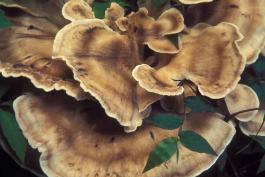
Large circular clusters; many fleshy, grayish yellow, fan-shaped caps; bruising black when cut or touched. Grows on the ground around stumps and bases of living deciduous trees, especially oaks. July–September. Each cap fan-shaped, semicircular, or spoon-shaped, with a thin, sharp margin; grayish to dull yellowish, darkening along the margin; bruises black when cut or touched; texture fleshy. Pores angular; white, bruising black. Stalk (if present) very short; thick; texture fibrous. Spore print white. Spores magnified are elliptical to round, smooth, colorless.
Lookalikes: Berkeley’s polypore (Bondarzewia berkeleyi) is thick-fleshed and cream-colored. Hen of the woods (Grifola frondosa) has many smaller, grayish brownish caps. Eastern cauliflower mushroom (Sparassis spatulata) has ribbonlike folds. None of these lookalikes bruise black.
Cluster width: to 32 inches; each cap width: 2–8 inches.

Statewide.
Habitat and Conservation
Grows in large circular clusters, on the ground around stumps of living deciduous trees, especially oaks. It can reappear in the same spot year after year.
Status
A good edible, when young and fresh. The black-staining polypore has a lovely, earthy odor. Though it is not terribly appealing as it blackens, when young and easy to cut it can be eaten and is quite good. Use only the softer outer edges of the caps. Long, slow cooking is best. Unlike most other edible mushrooms, which should be cooked before freezing to maintain good texture, these can be frozen raw.
Life Cycle
This species lives as a network of cells (mycelium) within living trees as a parasite, and dead stumps as a saprobe, digesting and decomposing the wood. When ready to reproduce, the mycelium develops the cluster of mushrooms that emerge from near the base of the tree, which are reproductive structures. Spores are produced in pores on the undersides of the caps and are released to begin new mycelia elsewhere.
Human Connections
Humans have eaten mushrooms for thousands of years, in many cultures, for various purposes. Some are eaten for their nutritional and culinary value; some are considered medicinal. Even the ones that can't be eaten can be appreciated for their forms and colors.
Ecosystem Connections
Fungi are vitally important for a healthy ecosystem. This fungus feeds on dead or dying trees, decomposing them in the process. This cleans the forest and helps nutrients to cycle back into the soil — an unglamorous but vital role in the ecosystem.




Mushrooms are a lot like plants, but they lack chlorophyll and have to take nutrients from other materials. Mushrooms are neither plants nor animals. They are in a different kingdom — the fungi. Fungi include the familiar mushroom-forming species, plus the yeasts, molds, smuts, and rusts.
Always be cautious when eating edible mushrooms. Be absolutely sure of the ID, and only eat a small amount the first time you try it to avoid a reaction..





















